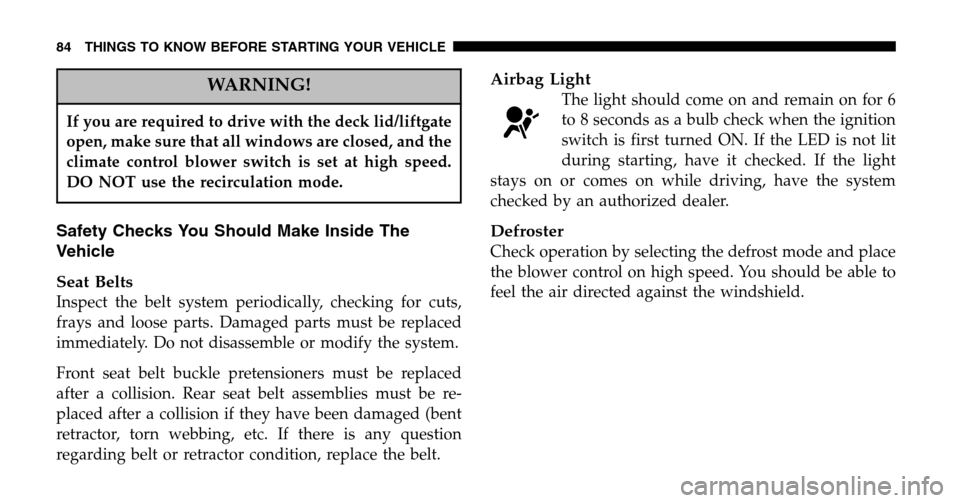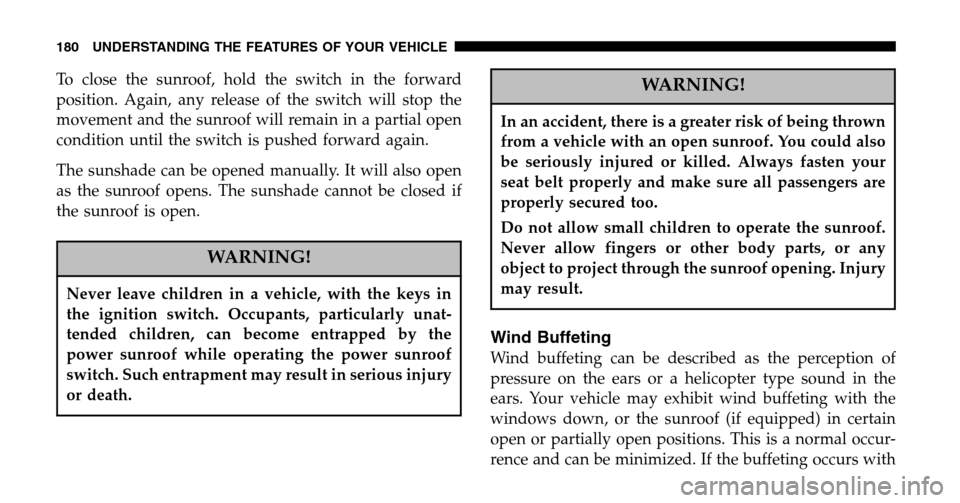Page 80 of 496

FACING TO THE REAR IN A VEHICLE EQUIPPED
WITH THE REAR SEAT DELETE FEATURE (Com-
mercial Vehicles Only). When a convertible seat is
properly installed forward facing, the vehicle seat
should be adjusted to the rear most position.
•Children more than 40 lbs (18 kg) should be secured in
the passenger seat in a child restraint or belt-
positioning booster seat with the seat adjusted to the
rear most position . Older children who do not use
child restraints or belt-positioning booster seats
should ride properly buckled in the passenger seat
with the seat adjusted to the rear most position. Never
allow children to slide the shoulder belt behind them
or under their arm.
Tether Installation For Commercial Vehicles With
Rear Seat Delete
To secure the child restraint upper tether strap to the
vehicle, follow the instructions shown: 1. Locate the child restraint tether anchor on the floor
just behind the front passenger seat.
2. Extend the child restraint tether anchor forward to-
wards the front passenger seat.
Tether Anchor Location
80 THINGS TO KNOW BEFORE STARTING YOUR VEHICLE
Page 84 of 496

WARNING!
If you are required to drive with the deck lid/liftgate
open, make sure that all windows are closed, and the
climate control blower switch is set at high speed.
DO NOT use the recirculation mode.
Safety Checks You Should Make Inside The
Vehicle
Seat Belts
Inspect the belt system periodically, checking for cuts,
frays and loose parts. Damaged parts must be replaced
immediately. Do not disassemble or modify the system.
Front seat belt buckle pretensioners must be replaced
after a collision. Rear seat belt assemblies must be re-
placed after a collision if they have been damaged (bent
retractor, torn webbing, etc. If there is any question
regarding belt or retractor condition, replace the belt.
Airbag Light
The light should come on and remain on for 6
to 8 seconds as a bulb check when the ignition
switch is first turned ON. If the LED is not lit
during starting, have it checked. If the light
stays on or comes on while driving, have the system
checked by an authorized dealer.
Defroster
Check operation by selecting the defrost mode and place
the blower control on high speed. You should be able to
feel the air directed against the windshield.
84 THINGS TO KNOW BEFORE STARTING YOUR VEHICLE
Page 120 of 496
Using body pressure, move forward and rearward on the
seat to be sure the seat adjusters have latched.
WARNING!
Adjust the seat only while the vehicle is parked.
Adjusting a seat while the vehicle is moving is
dangerous. The sudden movement of the seat could
cause you to lose control. The seat belt might not be
properly adjusted and you could be injured.
8–Way Driver’s Power Seat — If Equipped
The driver’s power seat switches are located on the
outboard side of the seat. The front switch controls
up/down, forward/rearward, and tilt adjustment. The
rear switch controls the seatback recline adjustment.6–Way Passenger’s Power Seat — If Equipped
The front passenger’s power seat switches are located on
the outboard side of the seat. The front switch controls
forward, rearward and vertical up and down adjustment
of the front of the seat only. The rear switch controls the
seatback recline adjustment.
Driver Power Seat Switch
120 UNDERSTANDING THE FEATURES OF YOUR VEHICLE
Page 123 of 496
WARNING!
Do not ride with the seatback reclined so that the
shoulder belt is no longer resting against your chest.
In a collision you could slide under the seat belt and
be seriously or fatally injured. Use the recliner only
when the vehicle is parked.
Manual Reclining Seat Control
UNDERSTANDING THE FEATURES OF YOUR VEHICLE 123
3
Page 142 of 496

If the seat is not occupied, the seatback can be folded
forward to obtain additional cargo space. To fold the
seatback forward, pull the handle labeled “1” located
behind the seat on the passenger side.
The seatback will latch in the folded position. To assure
the seatback is latched in the folded position, additional
downward pressure on the seatback may be required
when folding.
The same lever is used to return the seatback to the
upright position.
NOTE: The head restraints are removable, if needed. To
remove them, press the release tab on the right side of the
base of the head restraint.WARNING!
•Not all head restraints in this vehicle are the same.
Head restraints from one seating position should not
be removed and installed in any other seating posi-
tion. In a collision, serious injury or death may result
if the proper head restraint is not installed on each
seat.
•The cargo area in the rear of the vehicle should not
be used as a play area by children. They could be
seriously injured in a collision. Children should be
seated and using the proper restraint system.
•It is extremely dangerous to ride in a cargo area,
inside or outside of a vehicle. In a collision, people
riding in these areas are more likely to be seriously
injured or killed.
•Do not allow people to ride in any area of your
vehicle that is not equipped with seats and seat belts.
•Be sure everyone in your vehicle is in a seat and
using a seat belt properly.
142 UNDERSTANDING THE FEATURES OF YOUR VEHICLE
Page 180 of 496

To close the sunroof, hold the switch in the forward
position. Again, any release of the switch will stop the
movement and the sunroof will remain in a partial open
condition until the switch is pushed forward again.
The sunshade can be opened manually. It will also open
as the sunroof opens. The sunshade cannot be closed if
the sunroof is open.
WARNING!
Never leave children in a vehicle, with the keys in
the ignition switch. Occupants, particularly unat-
tended children, can become entrapped by the
power sunroof while operating the power sunroof
switch. Such entrapment may result in serious injury
or death.
WARNING!
In an accident, there is a greater risk of being thrown
from a vehicle with an open sunroof. You could also
be seriously injured or killed. Always fasten your
seat belt properly and make sure all passengers are
properly secured too.
Do not allow small children to operate the sunroof.
Never allow fingers or other body parts, or any
object to project through the sunroof opening. Injury
may result.
Wind Buffeting
Wind buffeting can be described as the perception of
pressure on the ears or a helicopter type sound in the
ears. Your vehicle may exhibit wind buffeting with the
windows down, or the sunroof (if equipped) in certain
open or partially open positions. This is a normal occur-
rence and can be minimized. If the buffeting occurs with
180 UNDERSTANDING THE FEATURES OF YOUR VEHICLE
Page 212 of 496

10. Anti-Lock Light This light monitors the Anti-Lock Brake Sys-
tem. The light will turn on when the ignition
switch is turned to the ON position and may
stay on for as long as four seconds.
If the ABS light remains on or turns on while driving, it
indicates that the Anti-Lock portion of the brake system
is not functioning and that service is required. However,
the conventional brake system will continue to operate
normally if the BRAKE warning light is not on.
If the ABS light is on, the brake system should be serviced
as soon as possible to restore the benefits of Anti-Lock
brakes. If the ABS light does not turn on when the
Ignition switch is turned to the ON position, have the
light inspected by an authorized dealer. (See page 319 for
more information.) 11. Tachometer — If Equipped
The red segments indicate the maximum permissible
engine revolutions-per-minute (r.p.m. x 1000) for each
gear range. Before reaching the red area, ease up on the
accelerator.
12. Voltage Light
This light monitors the electrical system voltage.
The light should turn on momentarily as the
engine is started. If the light stays on or turns on while
driving, it indicates a problem with the charging system.
Immediate service should be obtained.
13. Seat Belt Reminder Light When the ignition switch is first turned ON, this
light will turn on for 5 to 8 seconds as a bulb check.
During the bulb check, if the driver’s seat belt is
unbuckled, a chime will sound. After the bulb check or
when driving, if the driver seat belt remains unbuckled,
the Seat Belt Warning Light will flash or remain on
212 UNDERSTANDING YOUR INSTRUMENT PANEL
Page 213 of 496

continuously. Refer to�Enhanced Driver Seat Belt Re-
minder System (BeltAlert™) �in the Occupant Restraints
section for more information.
14. Engine Temperature Warning Light This light warns of an overheated engine condi-
tion. If the engine is critically hot, a continuous
chime will sound for 4 minutes. After the chime
turns off, the engine will still be critically hot until the
light turns off.
15. Vehicle Theft Alarm Light — If Equipped This light will flash for approximately 15 sec-
onds when the vehicle theft alarm is arming.
(See page 27 for more information.)
16. Temperature Gauge
The temperature gauge shows engine coolant tempera-
ture. Any reading within the normal range indicates that
the engine cooling system is operating satisfactorily. The gauge pointer will likely indicate a higher tempera-
ture when driving in hot weather, up mountain grades,
or when towing a trailer. It should not be allowed to
exceed the upper limits of the normal operating range.
CAUTION!
Driving with a hot engine cooling system could
damage your vehicle. If temperature gauge reads (H),
pull over and stop the vehicle. Idle the vehicle with
the air conditioner turned off until the pointer drops
back into the normal range. If the pointer remains on
the “H”, and you hear continuous chimes, turn the
engine off immediately, and call for service.
UNDERSTANDING YOUR INSTRUMENT PANEL 213
4